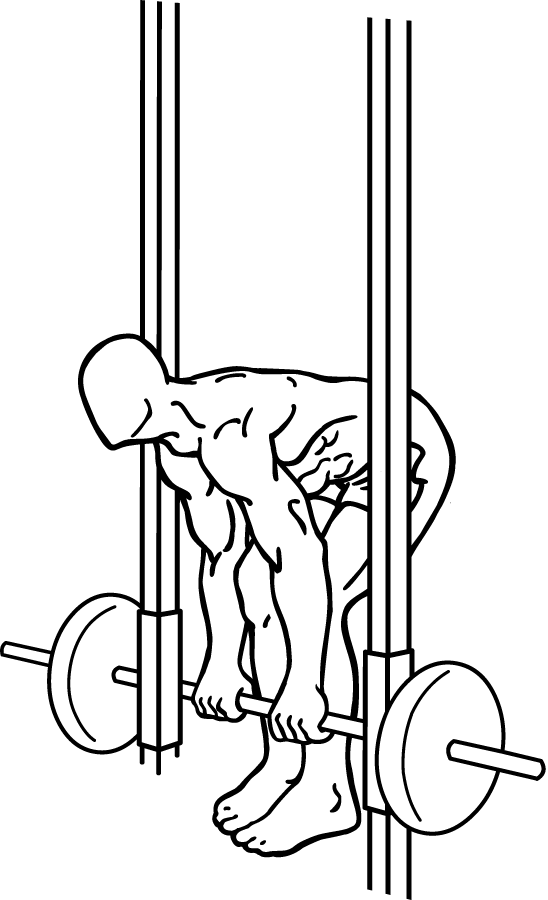Last Updated on September 26, 2014
The Smith Machine Deadlift is a versatile and effective exercise for building total-body strength while minimizing the risk of improper form. Using the Smith Machine adds stability and control, making it an excellent option for beginners, those recovering from injuries, or anyone looking to perfect their deadlift mechanics.
In this comprehensive guide, we’ll cover the benefits, step-by-step instructions, common mistakes, variations, and how to incorporate the Smith Machine Deadlift into your routine. Whether you’re targeting your hamstrings, glutes, or back, this exercise is a must-try for improving strength and muscle definition.
Why Choose the Smith Machine Deadlift?
The deadlift is often called the “king of lifts” because it engages multiple muscle groups and promotes functional strength. The Smith Machine Deadlift offers unique advantages:
1. Controlled Movement
The fixed bar path provides stability and helps lifters maintain proper form, reducing the risk of injury.
2. Muscle Isolation
The guided motion allows you to focus on specific muscle groups—hamstrings, glutes, and lower back—without worrying about balancing the bar.
3. Beginner-Friendly
The Smith Machine is perfect for those new to deadlifting, as it minimizes common form errors and increases confidence.
4. Progressive Overload
By ensuring consistent bar path and form, you can safely increase weight and track progress over time.
5. Rehabilitation Tool
If you’re recovering from an injury, the Smith Machine Deadlift offers a safer alternative to traditional free-weight deadlifts.
Muscles Worked
The Smith Machine Deadlift is a compound exercise that targets several muscle groups:
- Primary Muscles:
- Hamstrings
- Gluteus Maximus
- Erector Spinae (Lower Back)
- Secondary Muscles:
- Quadriceps
- Trapezius (Upper Back)
- Core (for stability)
- Stabilizers:
- Forearms (to grip the bar)
- Lats (to maintain posture)
How to Perform the Smith Machine Deadlift
Step-by-Step Instructions
Follow these steps to ensure proper technique and maximize the benefits of the Smith Machine Deadlift:
1. Set Up the Machine
- Position the bar at shin height on the Smith Machine. If the bar isn’t adjustable, use weight plates to elevate it to the correct height.
2. Position Your Feet
- Stand with your feet shoulder-width apart.
- Place your feet under the bar so the bar is directly over the middle of your feet.
3. Grip the Bar
- Bend at the hips and knees to reach the bar.
- Use an overhand grip with your hands approximately 16 inches apart. Ensure your palms face downward and your wrists are straight.
4. Engage Your Core
- Tighten your core muscles to stabilize your spine.
- Keep your chest up and your back straight to avoid rounding your lower back.
5. Lift the Bar
- Push through your heels and extend your hips and knees simultaneously.
- Keep the bar close to your body as you lift, stopping when your torso is fully upright and your arms are straight.
6. Lower the Bar
- Hinge at the hips and bend your knees slightly to lower the bar back down.
- Stop when the bar is just above the floor, keeping your back straight and your core engaged.
7. Repeat
- Perform the desired number of repetitions, maintaining control throughout each lift.
Tips for Perfect Form
- Maintain a Neutral Spine: Avoid rounding your lower back during the lift. A straight back protects your spine and engages the right muscles.
- Keep the Bar Close: The bar should stay close to your legs during both the lifting and lowering phases to maximize efficiency and safety.
- Engage Your Core: Tighten your abdominal muscles to stabilize your torso and prevent lower back strain.
- Use Your Hips: Focus on driving the movement through your hips, not your lower back.
- Breath Control: Inhale before lifting the bar and exhale as you reach the top of the movement.
Common Mistakes to Avoid
Even with the added stability of the Smith Machine, improper form can limit your results or cause injuries. Avoid these common errors:
1. Rounding the Back
- Letting your lower back round increases the risk of spinal injuries.
- Fix: Keep your spine neutral and engage your core throughout the movement.
2. Using Too Much Weight
- Lifting heavier than you can control often leads to poor form.
- Fix: Start with lighter weights and gradually increase as you master the technique.
3. Placing the Bar Too Far from Your Body
- If the bar drifts away from your body, you lose efficiency and increase strain on your lower back.
- Fix: Keep the bar as close as possible to your legs.
4. Locking the Knees
- Locking your knees at the top of the lift reduces muscle engagement and increases joint strain.
- Fix: Keep a slight bend in your knees even at full extension.
5. Overarching the Back at the Top
- Overextending your back at the top of the lift shifts tension away from the target muscles.
- Fix: Stop when your torso is upright, avoiding excessive arching.
Variations of the Smith Machine Deadlift
Adding variations to your routine can target specific muscle groups and add variety to your workouts:
1. Romanian Deadlift
- Keep your knees slightly bent throughout the movement to place more emphasis on the hamstrings and glutes.
2. Stiff-Leg Deadlift
- Perform the lift with minimal knee bend to maximize hamstring engagement.
3. Sumo Deadlift
- Use a wider stance with your toes pointing outward to target the inner thighs and glutes.
4. Trap Bar Smith Machine Deadlift
- Mimic a trap bar deadlift by holding the bar slightly wider than shoulder-width.
5. Single-Leg Smith Machine Deadlift
- Perform the movement on one leg to improve balance and isolate the glutes and hamstrings of the working leg.
Reps and Sets Recommendations
Your training goals will determine the optimal number of sets and reps:
- For Strength: 3–5 sets of 4–6 reps with heavier weight.
- For Muscle Growth (Hypertrophy): 3–4 sets of 8–12 reps with moderate weight.
- For Endurance: 2–3 sets of 12–15 reps with lighter weight.
Incorporating Smith Machine Deadlifts into Your Workout
1. Leg Day
Pair the Smith Machine Deadlift with exercises like squats, lunges, and leg curls to create a comprehensive lower-body routine.
2. Back Day
Combine this lift with pull-ups, rows, and lat pulldowns to build a strong, defined back.
3. Full-Body Workout
Use the Smith Machine Deadlift as a primary compound movement in a full-body workout, alongside presses and pulls.
Benefits Beyond the Gym
The benefits of the Smith Machine Deadlift extend beyond aesthetics and gym performance:
1. Functional Strength
Improved posterior chain strength translates to better performance in everyday activities like lifting, carrying, and bending.
2. Injury Prevention
By strengthening the hamstrings, glutes, and lower back, this exercise helps reduce the risk of injuries during physical activities.
3. Posture Improvement
Building a strong posterior chain supports better posture and reduces the risk of back pain caused by prolonged sitting.
Safety Considerations
- Warm Up
Perform 5–10 minutes of light cardio and dynamic stretches to prepare your muscles and joints. - Check the Machine
Ensure the Smith Machine is in good working condition before starting. - Use Safety Stops
Adjust the safety catches to prevent the bar from dropping too low. - Listen to Your Body
Stop immediately if you experience pain or discomfort and consult a fitness professional if needed.
FAQs
1. Can beginners do the Smith Machine Deadlift?
Yes! The stability and guided bar path make it an excellent choice for those new to weightlifting.
2. How often should I perform this exercise?
Incorporate it 1–2 times per week, ensuring sufficient recovery between sessions.
3. Should I use lifting straps?
If grip strength is a limiting factor, straps can help you focus on the target muscles.
Conclusion
The Smith Machine Deadlift is a valuable addition to any workout routine, offering a controlled and effective way to build strength in the posterior chain. Whether you’re a beginner perfecting your form or an advanced lifter seeking variety, this exercise can help you achieve your fitness goals.
By following proper technique, avoiding common mistakes, and experimenting with variations, you’ll unlock the full potential of this lift. Add it to your routine today and experience the benefits of stronger legs, glutes, and back muscles!








